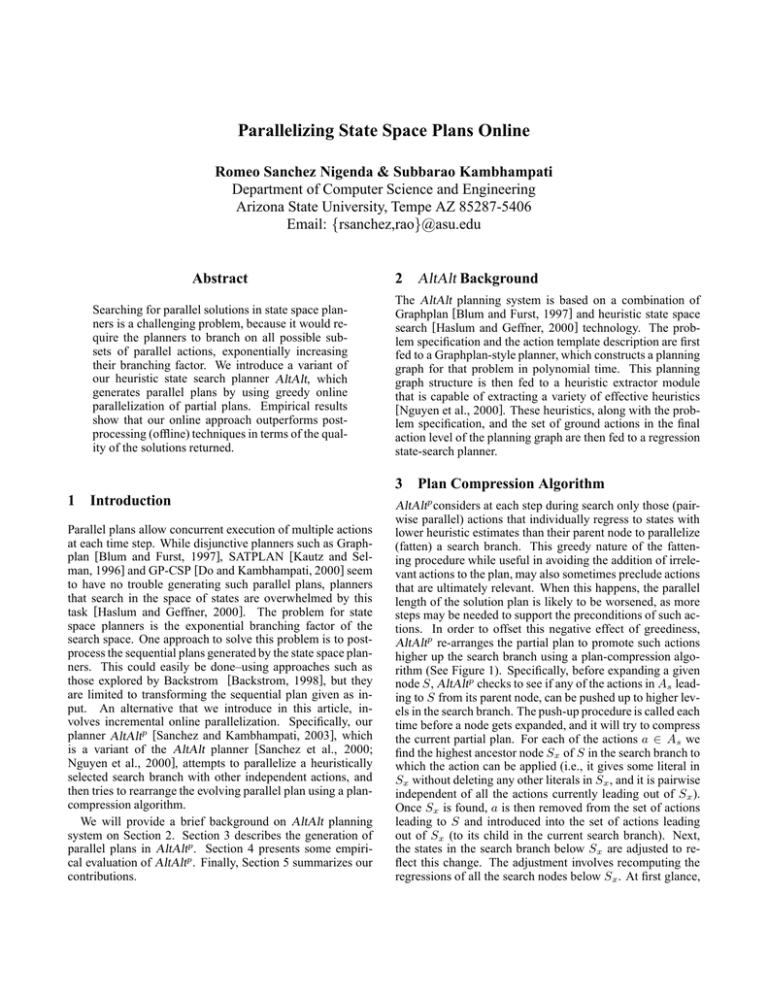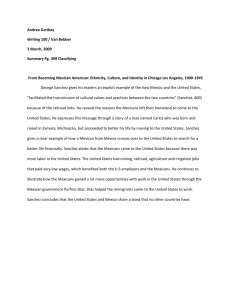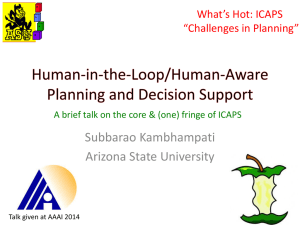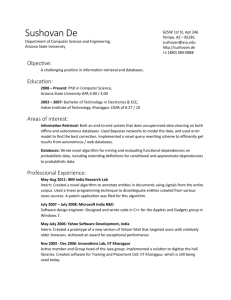Parallelizing State Space Plans Online AltAlt Romeo Sanchez Nigenda & Subbarao Kambhampati Abstract
advertisement

Parallelizing State Space Plans Online
Romeo Sanchez Nigenda & Subbarao Kambhampati
Department of Computer Science and Engineering
Arizona State University, Tempe AZ 85287-5406
Email: {rsanchez,rao}@asu.edu
Abstract
Searching for parallel solutions in state space planners is a challenging problem, because it would require the planners to branch on all possible subsets of parallel actions, exponentially increasing
their branching factor. We introduce a variant of
our heuristic state search planner AltAlt, which
generates parallel plans by using greedy online
parallelization of partial plans. Empirical results
show that our online approach outperforms postprocessing (offline) techniques in terms of the quality of the solutions returned.
2 AltAlt Background
The AltAlt planning system is based on a combination of
Graphplan [Blum and Furst, 1997] and heuristic state space
search [Haslum and Geffner, 2000] technology. The problem specification and the action template description are first
fed to a Graphplan-style planner, which constructs a planning
graph for that problem in polynomial time. This planning
graph structure is then fed to a heuristic extractor module
that is capable of extracting a variety of effective heuristics
[Nguyen et al., 2000]. These heuristics, along with the problem specification, and the set of ground actions in the final
action level of the planning graph are then fed to a regression
state-search planner.
3 Plan Compression Algorithm
1 Introduction
Parallel plans allow concurrent execution of multiple actions
at each time step. While disjunctive planners such as Graphplan [Blum and Furst, 1997], SATPLAN [Kautz and Selman, 1996] and GP-CSP [Do and Kambhampati, 2000] seem
to have no trouble generating such parallel plans, planners
that search in the space of states are overwhelmed by this
task [Haslum and Geffner, 2000]. The problem for state
space planners is the exponential branching factor of the
search space. One approach to solve this problem is to postprocess the sequential plans generated by the state space planners. This could easily be done–using approaches such as
those explored by Backstrom [Backstrom, 1998], but they
are limited to transforming the sequential plan given as input. An alternative that we introduce in this article, involves incremental online parallelization. Specifically, our
planner AltAltp [Sanchez and Kambhampati, 2003], which
is a variant of the AltAlt planner [Sanchez et al., 2000;
Nguyen et al., 2000], attempts to parallelize a heuristically
selected search branch with other independent actions, and
then tries to rearrange the evolving parallel plan using a plancompression algorithm.
We will provide a brief background on AltAlt planning
system on Section 2. Section 3 describes the generation of
parallel plans in AltAltp . Section 4 presents some empirical evaluation of AltAltp . Finally, Section 5 summarizes our
contributions.
AltAltp considers at each step during search only those (pairwise parallel) actions that individually regress to states with
lower heuristic estimates than their parent node to parallelize
(fatten) a search branch. This greedy nature of the fattening procedure while useful in avoiding the addition of irrelevant actions to the plan, may also sometimes preclude actions
that are ultimately relevant. When this happens, the parallel
length of the solution plan is likely to be worsened, as more
steps may be needed to support the preconditions of such actions. In order to offset this negative effect of greediness,
AltAltp re-arranges the partial plan to promote such actions
higher up the search branch using a plan-compression algorithm (See Figure 1). Specifically, before expanding a given
node S, AltAltp checks to see if any of the actions in As leading to S from its parent node, can be pushed up to higher levels in the search branch. The push-up procedure is called each
time before a node gets expanded, and it will try to compress
the current partial plan. For each of the actions a ∈ As we
find the highest ancestor node Sx of S in the search branch to
which the action can be applied (i.e., it gives some literal in
Sx without deleting any other literals in Sx , and it is pairwise
independent of all the actions currently leading out of Sx ).
Once Sx is found, a is then removed from the set of actions
leading to S and introduced into the set of actions leading
out of Sx (to its child in the current search branch). Next,
the states in the search branch below Sx are adjusted to reflect this change. The adjustment involves recomputing the
regressions of all the search nodes below Sx . At first glance,
Figure 1: Push Up Procedure
this might seem like a transformation of questionable utility
since the preconditions of a (and their regressions) just become part of the descendants of Sx , and this does not necessarily reduce the length of the plan. We however expect a
length reduction because actions supporting the preconditions
of a will get “pushed up” eventually during later expansions.
4 Empirical Evaluation
We compare our online parallelization approach to postprocessing, we have implemented Backstrom’s ‘Minimal Deordering Algorithm” from [Backstrom, 1998], and used it to
post-process the sequential plans produced by AltAlt. We
can see on Figure 2 some empirical results on the Zeno domain [Long and Fox, 2002].
As expected, the original AltAlt has the longest plans since
it allows only one action per time step. The plot shows that
post-processing techniques do help in reducing the makespan
of the plans generated by AltAlt. However, we also notice that AltAltp outputs plans with better makespan than
either AltAlt or AltAlt followed by post-processing. This
shows that online parallelization is a better approach than
post-processing sequential plans. AltAltp also does not result
in any additional run-time overhead with respect to AltAlt.
Further experiments reported in [Sanchez and Kambhampati,
2003] show that our approach is competitive or outperforms
other state of the art approaches in generating parallel plans.
5 Conclusions
We have introduced an approach to generate parallel plans
in the context of state space search. Our approach tries to
avoid the branching factor blow up by greedy and online parallelization of the evolving partial plans. A plan compression
procedure is used to offset the ill effects of the greedy search.
Our empirical results show that our approach seems to return
better quality plans than post-processing the sequential plans.
ZenoTravel AIPS-02
60
50
40
Steps
pushUP(S)
As ← get actions leading to S
forall a ∈ As
x←0
Sx ← get parent node of S
Loop
Ax ← get actions leading to Sx
If (parallel(a, Ax ))
x←x+1
Sx ← get parent node of Sx−1
Else
Ax−1 ← Ax−1 + a
As ← A s − a
End Loop
/**Adjusting the partial plan
Sx ← get highest ancestor x in history
createN ewBranchF rom(Sx)
while x > 0
Snew ← regress Sx with Ax−1
Sx ← Snew
x←x−1
END;
AltAlt
30
AltAlt-PostProc
AltAlt-p
20
10
0
1
2
3
4
5
6
7
8
9
10
11
12
13
14
15
Problems
Figure 2: AltAlt and Post-Processing vs AltAltp
In future, we plan to adapt the AltAltp approach to metric temporal domains, where the need of concurrency is more
pressing. It is in these scenarios where more powerful heuristics based on resource usage can be further investigated to
improve the parallelism of state space planners.
References
[Blum and Furst, 1997] A. Blum and M.L. Furst. Fast planning through planning graph analysis. In Artificial Intelligence. 90(1-2). 1997.
[Backstrom, 1998] C. Backstrom. Computational Aspects of
Reordering Plans In Journal of Artificial Intelligence Research, 1998.
[Long and Fox, 2002] D. Long and M. Fox. Results of the
AIPS 2002 Planning Competition.
URL: http://www.dur.ac.uk/d.p.long/competition.html.
[Kautz and Selman, 1996] H. Kautz and B. Selman. Pushing
the envelope: Planning propositional logic and stochastic
search. In Proc. AAAI 1996. Portland, OR.
[Do and Kambhampati, 2000] Minh B. Do, and S. Kambhampati. Solving Planning Graph by Compiling it into
a CSP. In Proc. AIPS 2000
[Haslum and Geffner, 2000] P. Haslum and H. Geffner. Admissible Heuristics for Optimal Planning. In Proc. AIPS
2000.
[Sanchez et al., 2000] R. Sanchez, X. Nguyen and S. Kambhampati. AltAlt: Combining the advantages of Graphplan
and Heuristics State Search. InProc. KBCS 2000. Bombay,
India.
[Sanchez and Kambhampati, 2003] R.
Sanchez
and
S. Kambhampati. AltAltp: Online Parallelization of
Plans with Heuristic State Search. To appear in JAIR.
[Nguyen et al., 2000] X. Nguyen, S. Kambhampati, and R.
Sanchez Nigenda. Planning Graph as the Basis for deriving Heuristics for Plan Synthesis by State Space and CSP
Search. In Journal of Artificial Intelligence, 2002.





